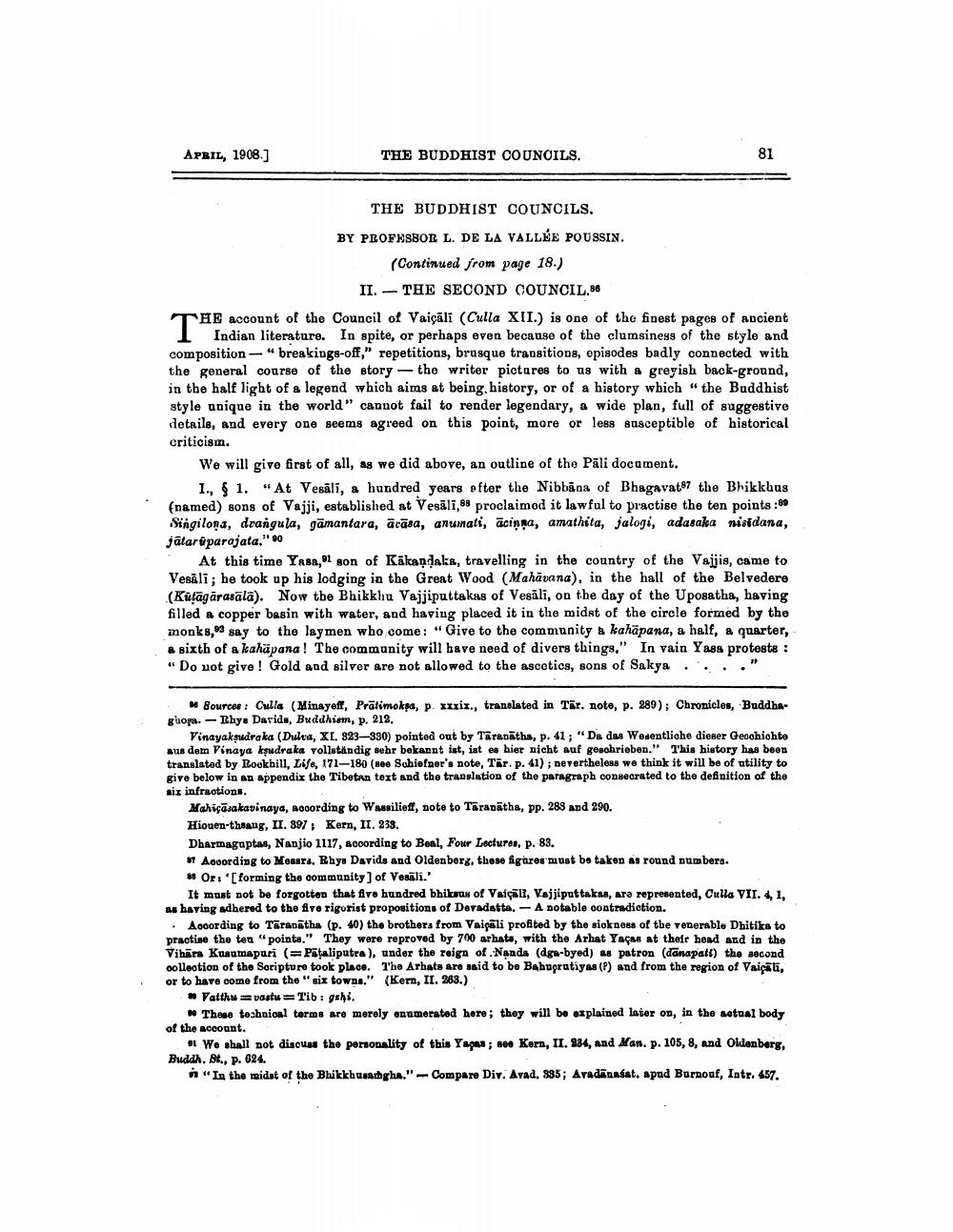________________
APRIL, 1908.]
THE BUDDHIST COUNCILS.
THE BUDDHIST COUNCILS. BY PROFESSOR L. DE LA VALLÉE POUSSIN.
(Continued from page 18.)
II. - THE SECOND COUNCIL. THE account of the Council of Vaicāli (Culla XII.) is one of the finest pages of ancient
1 Indian literature. In spite, or perhaps even because of the clumsiness of the style and composition - "breakings-off," repetitions, brusque transitions, episodes badly connected with the general course of the story -- the writer pictures to us with a greyish back-ground, in the half light of a legend which aims at being history, or of a history which the Buddhist style unique in the world" cannot fail to render legendary, a wide plan, full of suggestive details, and every one seems agreed on this point, more or less susceptible of historical criticism.
We will give first of all, as we did above, an outline of the Pāli document.
1., 1. "At Vesāli, a hundred years ofter the Nibbāna of Bhagavat87 the Bhikkhus (named) song of Vajji, established at Vesāli,88 proclaimod it lawful to practise the ten points:89 Singilona, drangula, gämantara, ācāsa, anumats, ācinna, amathita, jalogi, adasaka nistdana, jātarüparajata." 80
At this time Y 82,01 gon of Kākandaka, travelling in the country of the Vajjis, came to Vesäli; he took up his lodging in the Great Wood (Mahāvana), in the hall of the Belvedere (Kütāgārasālā). Now the Bhikkhu Vajjiputtakas of Vesāli, on the day of the Uposatha, having filled a copper basin with water, and haviug placed it in the midst of the circle formed by the monks," say to the laymen who come: "Give to the community a kahapana, a half, a quarter, A sixth of a kahapana! The community will have need of divers things." In vain Yasa proteste : "Do not give ! Gold and silver are not allowed to the ascetics, sons of Sakya ...."
* Sources: Culla (Minayeff, Prātimoka, p. xxxix., translated in Tar. note, p. 289); Chronicles, Buddhaghora. - Rhys Darids, Buddhism, p. 212.
Vinayakşudraka (Dulva, XL, 323-330) pointed out by Taranatha, p. 41; "Da das Wesentliche dieser Geschichte Bus dem Vinaya kşudraka vollständig sehr bekannt ist, ist es hier nicht auf geschrieben." This history has been translated by Rookhill, Life, 171-180 (see Suhiefner's note, Tär. p. 41); nevertheless we think it will be of atility to give below in an appendix the Tibetan text and the translation of the paragraph consecrated to the definition of the six infractions.
Mahigāsakavinaya, aooording to Wassilieff, note to Taranātha, pp. 289 and 290. Hiouen-thaaug, II. 891; Kern, II. 238. Dharmagaptas, Nanjio 1117, according to Beal, Four Lecturos, p. 83. » According to Mossra, Rhys Davids and Oldenberg, those figures must be taken as round numbers. * Or: '[forming the community) of Vesali.'
It must not be forgotten that five hundred bhiksus of Vaiçãli, Vajjiputtakas, ara represented, Culla VII. 4, 1, as having adhered to the five rigorist propositions of Devadatta. - A notable oontradiction. • According to Taranatha (p. 40) the brothers from Vaicāli profited by the siok ness of the venerable Dhitiks to practise the teu "points." They were reproved by 700 arhate, with the Arhat Yaças at their head and in the Vihara Kuamapuri (=Pauliputra), under the reign of Nanda (dga-byed) as patron (danapatt) the aecond collection of the Soripture took place. The Arbats are said to be Babupratiyas (P) and from the region of Vaicāta, or to have come from the " six towns." (Kern, II. 283.)
# Vatthu =vastu = Tib: gshi.
* These teshnical terms are merely enumerated hore; they will be explained later on, in the actual body of the account.
We shall not discuss the porsonality of this Yaças ; see Korn, II. 884, and Man. p. 105, 8, and Oldenberg, Buddh. St., p. 624.
In the midst of the Bhikkhusabgha." - Compare Dir. Arad, 885; Aradūnasat. apud Burnouf, Intr. 457.




